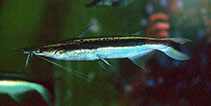| Family: |
Pimelodidae (Long-whiskered catfishes) |
| Max. size: |
54.2 cm TL (male/unsexed); max.weight: 1,300.0 g |
| Environment: |
demersal; freshwater; pH range: 6.5 - 7.80000019073486; dH range: 20 |
| Distribution: |
South America: Amazon, Orinoco, Paraná and Parnaíba River basins. Syntopic with S. elongatus in the Orinoco basin and with S. elongatus and S. maniradii in the upper Amazon drainage of Brazil, Ecuador, Peru, and Bolivia (Ref. 57983). |
| Diagnosis: |
Dorsal spines (total): 2-2; Dorsal soft rays (total): 6-6; Anal soft rays: 19-22. Distinguished from S. elongatus by having modally 9 pectoral rays; 21 anal-fin rays; 16 gill rakers; large vomerine tooth patches, almost always fused; a more robust, deeper head and body; body somewhat compressed laterally; mental barbels equal or anterior to gular apex. Differs from S. cuspicaudus in having rounded caudal fin lobes and more robust body; from S. trigonocephalus by premaxillary tooth patch length being 1.5 to 2.5 times its width; trenchantly differs from S. maniradii in having only 13-18 gill rakers. Additionally, other distinguishing characters include, pelvic fins that contact or nearly reach anal fin origin when depressed and presence of thin plates or ossicles (highly variable in shape) extending vertically on anterior lateral line in most large adults (Ref. 57983). |
| Biology: |
Occurs in schools. Is mainly nocturnal. Feeds primarily on fishes and crustaceans (Ref. 9084). |
| IUCN Red List Status: |
Least Concern (LC); Date assessed: 07 November 2018 Ref. (130435)
|
| Threat to humans: |
harmless |
Source and more info: www.fishbase.org. For personal, classroom, and other internal use only. Not for publication.

